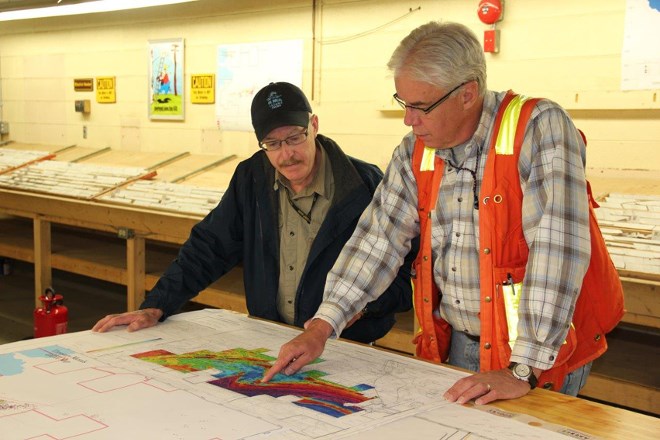John Mason always felt Thunder Bay missed the boat in capitalizing on the economic spinoffs from the Hemlo gold discovery in the mid-1980s.
As a government geologist working the north shore of Lake Superior, he witnessed that all the exploration know-how, drilling and assay work originated in Timmins, and mine-building muscle came from Sudbury.
Thunder Bay isn’t situated in the so-called “shadow of the headframe.” The nearest mine, North American Palladium’s Lac des Iles Mine, is located 85 kilometres away.
Historically, the city’s economy was heavily reliant on jobs in the forestry mills and the bustle of activity surrounding its Lake Superior grain port.
The mining and exploration sector wasn’t familiar, understood, nor appreciated by locals.
The handful of junior mining companies, geologists and prospectors were tucked away in an industrial park in the city’s core on streets named Alloy, Tungsten and Cobalt.
In his role with the City of Thunder Bay, Mason sees his role as being a “bridge” in keeping the resource industry front and centre in the public mind.
Now retired after 36 years on the job, the retired provincial geologist was hired as the city’s first dedicated mining economic development officer in 2011.
He serves as a communicator and mining industry liaison in parlaying his expertise and contacts to educate industrial suppliers, political leaders, and the general public on the mineral development opportunities on the community’s doorstep.
“The mining sector doesn’t necessarily talk well about itself, or talk enough about itself,” said Mason, the project manager of mining services with the Thunder Bay Community Economic Development Commission (CEDC).
Last November, Mason and the CEDC hosted an event in a hotel ballroom featuring a presentation by Greenstone Gold of its Hardrock open-pit mine development, near Geraldton, that drew 250 spectators from the city’s industrial supply community.
The turnout and the degree of interest only reinforces to Mason that Thunder Bay has come a long way in becoming a major service and supply hub, and workforce provider for the mining industry.
“We’ve evolved, significantly.”
In his estimation, close to 500 Thunder Bay companies are either directly involved in the industry or devote a portion of their business to it.
Northwestern Ontario offers a diverse range of mineral potential, but gold remains its backbone.
The 1.5 million ounces produced in 2017 represent 20 per cent of Canada’s total output in the precious metal, a figure that should only increase.
The prospects for new gold mines look promising, with Pure Gold in Red Lake, Treasury Metals in Dryden, and Greenstone Gold in Geraldton all close to reaching their respective permitting finish lines over the next three years.
The supply chains for these mines are enormous.
Of the $60 million spent by Goldcorp on supplies for its remote Musselwhite Mine in 2017, $45 million of that was spread out among 390 Thunder Bay companies.
“It’s an economy unto itself,” said Mason.
To formulate the big picture of what’s going on region-wide, Mason regularly works the phone or is travelling to mine sites, conversing with HR professionals, mine managers, supply chain procurement specialists, project geologists and prospectors to get the on-the-ground pulse of activity.
“As a civil servant, I realize a real economy is on the back of industry,” said Mason.
“How do I look through their eyes and create opportunity, whether it be the end user, the supplier, or the person looking for a job. It’s about being that ‘bridge’ in six-foot letters.”
During his tenure, the CEDC has posted an online mining supply directory, often stages company presentations, and in 2012 prepared a mining readiness plan, spurred by the excitement of the Ring of Fire.
The comprehensive strategy provided a checklist of the city’s and northwestern Ontario’s infrastructural strengths and weaknesses in transportation, electricity, business development, Indigenous partnerships, workforce, available land and housing supply, and potential research and development opportunities.
Though the city fell short in two attempts to host a ferrochrome processing plant, Mason insists the readiness strategy remained a useful planning exercise that’s still referenced today in hosting other industrial players who are scoping out Thunder Bay.
“We’re still using that document. The chapters are very live and in colour.”
A typical week often means immersing himself in pre-qualification bid lists, helping Fort William First Nation draft an economic development plan for its industrial lands, or arranging a targeted meeting between a local supplier and a mine procurement manager.
On the public education side, there are always updates provided to the CEDC’s board of directors and city council, and subject matter to assign for freelance articles on mining activity that appear in the local newspaper.
“Each week is different,” said Mason. “A lot of our role is to be that glue that brings opportunities to the suppliers, workforce, trade unions, educators, and leaders in the northwest identify opportunities and update projects.”
Heading into his eighth year on the job, Mason said the day-to-day variation always keeps it interesting, challenging and enjoyable.
“It’s the latitude to be able to work with a variety of players on projects of different levels,” said Mason, reflecting on the enjoyment of his position, “from a mine that’s expanding or is ready to close, to the new projects that are getting to the (permitting) finishing lines, to the grassroots ones, in helping them with the supply chain.
“But it’s still a people business, and that always gets my juices flowing.”
The Drift magazine, a new publication from Northern Ontario Business, features profiles on the people and companies making important contributions to the Northern Ontario mining service and supply industry.




